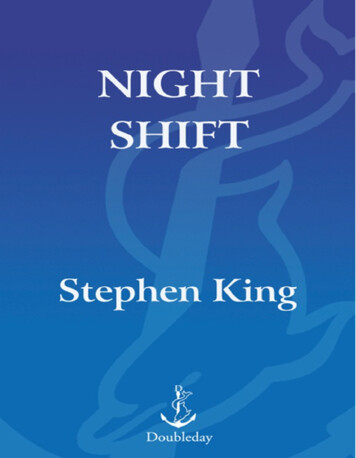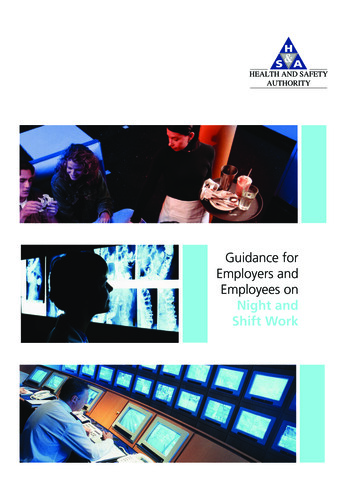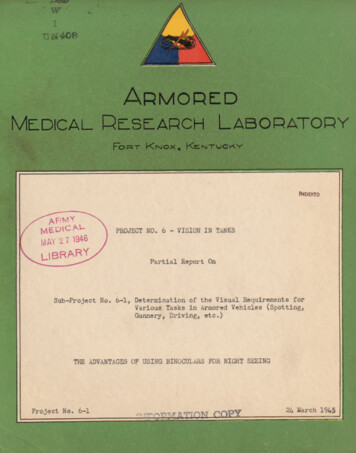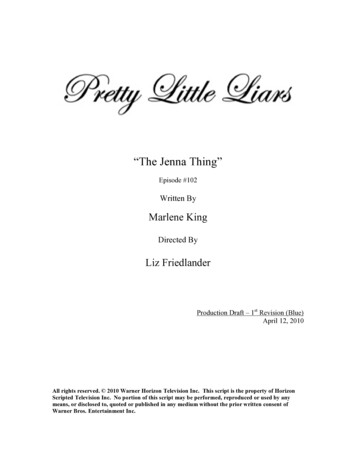
Transcription
NIGHTSHIFT
CONTENTSTitle PageIntroduction by John D. MacDonaldForewordJerusalem's LotGraveyard ShiftNight SurfI Am the DoorwayThe Mangler
The BoogeymanGray MatterBattlegroundTrucksSometimes They Come BackStrawberry SpringThe LedgeThe Lawnmower ManQuitters, Inc.I Know What You Need
Children of the CornThe Last Rung on the LadderThe Man Who Loved FlowersOne for the RoadThe Woman in the RoomBy Stephen KingCopyright
INTRODUCTIONI am often given the big smiling handshake at parties(which I avoid attending whenever possible) bysomeone who then, with an air of gleeful conspiracy,will say, “You know, I've always wanted to write.”I used to try to be polite.These days I reply with the same jubilant excitement:“You know, I've always wanted to be a brain surgeon.”They look puzzled. It doesn't matter. There are a lotof puzzled people wandering around lately.If you want to write, you write.The only way to learn to write is by writing. And thatwould not be a useful approach to brain surgery.Stephen King always wanted to write and he writes.So he wrote Carrie and 'Salem's Lot and TheShining, and the good short stories you can read in thisbook, and a stupendous number of other stories andbooks and fragments and poems and essays and otherunclassifiable things, most of them too wretched to ever
publish.Because that is the way it is done.Because there is no other way to do it. Not oneother way.Compulsive diligence is almost enough. But not quite.You have to have a taste for words. Gluttony. Youhave to want to roll in them. You have to read millionsof them written by other people.You read everything with grinding envy or a wearycontempt.You save the most contempt for the people whoconceal ineptitude with long words, Germanic sentencestructure, obtrusive symbols, and no sense of story,pace, or character.Then you have to start knowing yourself so well thatyou begin to know other people. A piece of us is inevery person we can ever meet.Okay, then. Stupendous diligence, plus word-love,plus empathy, and out of that can come, painfully, someobjectivity.Never total objectivity.At this frangible moment in time I am typing thesewords on my blue machine, seven lines down from the
top of my page two of this introduction, knowing clearlythe flavor and meaning I am hunting for, but not at allcertain I am getting it.Having been around twice as long as Stephen King, Ihave a little more objectivity about my work than he hasabout his.It comes so painfully and so slowly.You send books out into the world and it is veryhard to shuck them out of the spirit. They are tangledchildren, trying to make their way in spite of thehandicaps you have imposed on them. I would give apretty to get them all back home and take one last goodswing at every one of them. Page by page. Digging andcleaning, brushing and furbishing. Tidying up.Stephen King is a far, far better writer at thirty than Iwas at thirty, or at forty.I am entitled to hate him a little bit for this.And I think I know of a dozen demons hiding in thebushes where his path leads, and even if I had a way towarn him, it would do no good. He whips them or theywhip him.It is exactly that simple.Are we all together so far?
Diligence, word-lust, empathy equal growingobjectivity and then what?Story. Story. Dammit, story!Story is something happening to someone you havebeen led to care about. It can happen in any dimension—physical, mental, spiritual—and in combinations ofthose dimensions.Without author intrusion.Author intrusion is: “My God, Mama, look how niceI'm writing!”Another kind of intrusion is a grotesquerie. Here isone of my favorites, culled from a Big Best Seller ofyesteryear: “His eyes slid down the front of her dress.”Author intrusion is a phrase so inept the readersuddenly realizes he is reading, and he backs out of thestory. He is shocked back out of the story.Another author intrusion is the mini-lectureembedded in the story. This is one of my most grievousfailings.An image can be neatly done, be unexpected, andnot break the spell. In a story in this book called“Trucks,” Stephen King is writing about a tense sceneof waiting in a truck stop, describing the people: “He
was a salesman and he kept his display bag close tohim, like a pet dog that had gone to sleep.”I find that neat.In another story he demonstrates his good ear, thering of exactness and truth he can give dialogue. A manand his wife are on a long trip. They are traveling aback road. She says: “Yes, Burt. I know we're inNebraska, Burt. But where the hell are we?” He says:“You've got the road atlas. Look it up. Or can't youread?”Nice. It looks so simple. Just like brain surgery. Theknife has an edge. You hold it so. And cut.Now at risk of being an iconoclast I will say that I donot give a diddly-whoop what Stephen King chooses asan area in which to write. The fact that he presentlyenjoys writing in the field of spooks and spells andslitherings in the cellar is to me the least important anduseful fact about the man anyone can relate.There are a lot of slitherings in here, and there is amaddened pressing machine that haunts me, as it willyou, and there are enough persuasively evil children tofill Disney World on any Sunday in February, but themain thing is story.
One is led to care.Note this. Two of the most difficult areas to write inare humor and the occult. In clumsy hands the humorturns to dirge and the occult turns funny.But once you know how, you can write in any area.Stephen King is not going to restrict himself to hispresent field of intense interest.One of the most resonant and affecting stories in thisbook is “The Last Rung on the Ladder.” A gem. Nary arustle nor breath of other worlds in it.Final word.He does not write to please you. He writes to pleasehimself. I write to please myself. When that happens,you will like the work too. These stories pleasedStephen King and they pleased me.By strange coincidence on the day I write this,Stephen King's novel The Shining and my novelCondominium are both on the Best Seller List. We arenot in competition for your attention with each other.We are in competition, I suppose, with the inept andpretentious and sensational books published byhousehold names who have never really bothered tolearn their craft.
Insofar as story is concerned, and pleasure isconcerned, there are not enough Stephen Kings to goaround.If you have read this whole thing, I hope you haveplenty of time. You could have been reading the stories.JOHN D. MACDONALD
FOREWORDLet's talk, you and I. Let's talk about fear.The house is empty as I write this; a cold Februaryrain is falling outside. It's night. Sometimes when thewind blows the way it's blowing now, we lose thepower. But for now it's on, and so let's talk veryhonestly about fear. Let's talk very rationally aboutmoving to the rim of madness . . . and perhaps over theedge.My name is Stephen King. I am a grown man with awife and three children. I love them, and I believe thatthe feeling is reciprocated. My job is writing, and it's ajob I like very much. The stories—Carrie, 'Salem'sLot, and The Shining—have been successful enough toallow me to write full-time, which is an agreeable thingto be able to do. At this point in my life I seem to bereasonably healthy. In the last year I have been able toreduce my cigarette habit from the unfiltered brand Ihad smoked since I was eighteen to a low nicotine and
tar brand, and I still hope to be able to quit completely.My family and I live in a pleasant house beside arelatively unpolluted lake in Maine; last fall I awoke onemorning and saw a deer standing on the back lawn bythe picnic table. We have a good life.Still . . . let's talk about fear. We won't raise ourvoices and we won't scream; we'll talk rationally, youand I. We'll talk about the way the good fabric of thingssometimes has a way of unraveling with shockingsuddenness.At night, when I go to bed I still am at pains to besure that my legs are under the blankets after the lightsgo out. I'm not a child anymore but . . . I don't like tosleep with one leg sticking out. Because if a cool handever reached out from under the bed and grasped myankle, I might scream. Yes, I might scream to wake thedead. That sort of thing doesn't happen, of course, andwe all know that. In the stories that follow you willencounter all manner of night creatures; vampires,demon lovers, a thing that lives in the closet, all sorts ofother terrors. None of them are real. The thing undermy bed waiting to grab my ankle isn't real. I know that,and I also know that if I'm careful to keep my foot
under the covers, it will never be able to grab my ankle.Sometimes I speak before groups of people who areinterested in writing or in literature, and before thequestion-and-answer period is over, someone alwaysrises and asks this question: Why do you choose towrite about such gruesome subjects?I usually answer this with another question: Why doyou assume that I have a choice?Writing is a catch-as-catch-can sort of occupation.All of us seem to come equipped with filters on thefloors of our minds, and all the filters have differing sizesand meshes. What catches in my filter may run rightthrough yours. What catches in yours may pass throughmine, no sweat. All of us seem to have a built-inobligation to sift through the sludge that gets caught inour respective mind-filters, and what we find thereusually develops into some sort of sideline. Theaccountant may also be a photographer. Theastronomer may collect coins. The school-teacher maydo gravestone rubbings in charcoal. The sludge caughtin the mind's filter, the stuff that refuses to go through,frequently becomes each person's private obsession. In
civilized society we have an unspoken agreement to callour obsessions “hobbies.”Sometimes the hobby can become a full-time job.The accountant may discover that he can make enoughmoney to support his family taking pictures; theschoolteacher may become enough of an expert ongrave rubbings to go on the lecture circuit. And thereare some professions which begin as hobbies andremain hobbies even after the practitioner is able to earnhis living by pursuing his hobby; but because “hobby” issuch a bumpy, common-sounding little word, we alsohave an unspoken agreement that we will call ourprofessional hobbies “the arts.”Painting. Sculpture. Composing. Singing. Acting. Theplaying of a musical instrument. Writing. Enough bookshave been written on these seven subjects alone to sinka fleet of luxury liners. And the only thing we seem to beable to agree upon about them is this: that those whopractice these arts honestly would continue to practicethem even if they were not paid for their efforts; even iftheir efforts were criticized or even reviled; even on painof imprisonment or death. To me, that seems to be apretty fair definition of obsessional behavior. It applies
to the plain hobbies as well as the fancy ones we call“the arts”; gun collectors sport bumper stickers readingYOU WILL TAKE MY GUN ONLY WHEN YOU PRY MY COLDDEAD FINGERS FROM IT, and in the suburbs of Boston,housewives who discovered political activism during thebusing furor often sported similar stickers readingYOU'LL TAKE ME TO PRISON BEFORE YOU TAKE MYCHILDREN OUT OF THE NEIGHBORHOOD on the backbumpers of their station wagons. Similarly, if coincollecting were outlawed tomorrow, the astronomervery likely wouldn't turn in his steel pennies and buffalonickels; he'd wrap them carefully in plastic, sink them tothe bottom of his toilet tank, and gloat over them aftermidnight.We seem to be wandering away from the subject offear, but we really haven't wandered very far. Thesludge that catches in the mesh of my drain is often thestuff of fear. My obsession is with the macabre. I didn'twrite any of the stories which follow for money,although some of them were sold to magazines beforethey appeared here and I never once returned a checkuncashed. I may be obsessional but I'm not crazy. Yet Irepeat: I didn't write them for money; I wrote them
because it occurred to me to write them. I have amarketable obsession. There are madmen andmadwomen in padded cells the world over who are notso lucky.I am not a great artist, but I have always felt impelledto write. So each day I sift the sludge anew, goingthrough the cast-off bits and pieces of observation, ofmemory, of speculation, trying to make something outof the stuff that didn't go through the filter and down thedrain into the subconscious.Louis L'Amour, the Western writer, and I might bothstand at the edge of a small pond in Colorado, and weboth might have an idea at exactly the same time. Wemight both feel the urge to sit down and try to work itout in words. His story might be about water rights in adry season, my story would more likely be about somedreadful, hulking thing rising out of the still waters tocarry off sheep . . . and horses . . . and finally people.Louis L'Amour's “obsession” centers on the history ofthe American West; I tend more toward things thatslither by starlight. He writes Westerns; I writefearsomes. We're both a little bit nuts.The arts are obsessional, and obsession is
dangerous. It's like a knife in the mind. In some cases—Dylan Thomas comes to mind, and Ross Lockridge andHart Crane and Sylvia Plath—the knife can turnsavagely upon the person wielding it. Art is a localizedillness, usually benign—creative people tend to live along time—sometimes terribly malignant. You use theknife carefully, because you know it doesn't care who itcuts. And if you are wise you sift the sludge carefully . . because some of that stuff may not be dead.After the why do you write that stuff question hasbeen disposed of, the companion question comes up:Why do people read that stuff? What makes it sell?This question carries a hidden assumption with it, andthe assumption is that the story about fear, the storyabout horror, is an unhealthy taste. People who writeme often begin by saying, “I suppose you will think I'mstrange, but I really liked 'Salem's Lot” or “ProbablyI'm morbid, but I enjoyed every page of The Shining . .”I think the key to this may lie in a line of moviecriticism from Newsweek magazine. The review was ofa horror film, not a very good one, and it went
something like this: “. . . a wonderful movie for peoplewho like to slow down and look at car accidents.” It's agood snappy line, but when you stop and think about it,it applies to all horror films and stories. The Night ofthe Living Dead, with its gruesome scenes of humancannibalism and matricide, was certainly a film forpeople who like to slow down and look at caraccidents; and how about that little girl puking pea soupall over the priest in The Exorcist? Bram Stoker'sDracula, often a basis of comparison for the modernhorror story (as it should be; it is the first withunabashedly psycho-Freudian overtones), features amaniac named Renfield who gobbles flies, spiders, andfinally a bird. He regurgitates the bird, having eaten itfeathers and all. The novel also features the impalement—the ritual penetration, one could say—of a young andlovely female vampire and the murder of a baby and thebaby's mother.The great literature of the supernatural often containsthe same “let's slow down and look at the accident”syndrome: Beowulf slaughtering Grendel's mother; thenarrator of “The Tell-Tale Heart” dismembering hiscataract-stricken benefactor and putting the pieces
under the floorboards; the Hobbit Sam's grim battlewith Shelob the spider in the final book of Tolkien'sRings trilogy.There will be some who will object strenuously tothis line of thought, saying that Henry James is notshowing us a car accident in The Turn of the Screw;they will claim that Nathaniel Hawthorne's stories of themacabre, such as “Young Goodman Brown” and “TheMinister's Black Veil,” are also rather more tasteful thanDracula. It's a nonsensical idea. They are still showingus the car accident; the bodies have been removed butwe can still see the twisted wreckage and observe theblood on the upholstery. In some ways the delicacy, thelack of melodrama, the low and studied tone ofrationality that pervades a story like “The Minister'sBlack Veil” is even more terrible than Lovecraft'sbatrachian monstrosities or the auto-da-fé of Poe's“The Pit and the Pendulum.”The fact is—and most of us know this in our hearts—that very few of us can forgo an uneasy peek at thewreckage bracketed by police cars and road flares onthe turnpike at night. Senior citizens pick up the paper inthe morning and immediately turn to the obituary column
so they can see who they outlived. All of us are uneasilytransfixed for a moment when we hear that a DanBlocker has died, a Freddie Prinze, a Janis Joplin. Wefeel terror mixed with an odd sort of glee when we hearPaul Harvey on the radio telling us that a womanwalked into a propeller blade during a rain squall at asmall country airport or that a man in a giant industrialblender was vaporized immediately when a co-workerstumbled against the controls. No need to belabor theobvious; life is full of horrors small and large, butbecause the small ones are the ones we cancomprehend, they are the ones that smack home withall the force of mortality.Our interest in these pocket horrors is undeniable,but so is our own revulsion. The two of them mixuneasily, and the by-product of the mix seems to beguilt . . . a guilt which seems not much different from theguilt that used to accompany sexual awakening.It is not my business to tell you not to feel guilty, anymore than it is my business to justify my novels or theshort stories which follow. But an interesting parallelbetween sex and fear can be observed. As we becomecapable of having sexual relationships, our interest in
those relationships awakens; the interest, unlessperverted somehow, tends naturally toward copulationand the continuance of the species. As we becomeaware of our own unavoidable termination, we becomeaware of the fear-emotion. And I think that, ascopulation tends toward self-preservation, all fear tendstoward a comprehension of the final ending.There is an old fable about seven blind men whograbbed seven different parts of an elephant. One ofthem thought he had a snake, one of them thought hehad a giant palm leaf, one of them thought he wastouching a stone pillar. When they got together, theydecided they had an elephant.Fear is the emotion that makes us blind. How manythings are we afraid of? We're afraid to turn off thelights when our hands are wet. We're afraid to stick aknife into the toaster to get the stuck English muffinwithout unplugging it first. We're afraid of what thedoctor may tell us when the physical exam is over;when the airplane suddenly takes a great unearthly lurchin midair. We're afraid that the oil may run out, that thegood air will run out, the good water, the good life.When the daughter promised to be in by eleven and it's
now quarter past twelve and sleet is spatting against thewindow like dry sand, we sit and pretend to watchJohnny Carson and look occasionally at the mutetelephone and we feel the emotion that makes us blind,the emotion that makes a stealthy ruin of the thinkingprocess.The infant is a fearless creature only until the first timethe mother isn't there to pop the nipple into his mouthwhen he cries. The toddler quickly discovers the bluntand painful truths of the slamming door, the hot burner,the fever that goes with the croup or the measles.Children learn fear quickly; they pick it up off themother or father's face when the parent comes into thebathroom and sees them with the bottle of pills or thesafety razor.Fear makes us blind, and we touch each fear with allthe avid curiosity of self-interest, trying to make a wholeout of a hundred parts, like the blind men with theirelephant.We sense the shape. Children grasp it easily, forgetit, and relearn it as adults. The shape is there, and mostof us come to realize what it is sooner or later: it is theshape of a body under a sheet. All our fears add up to
one great fear, all our fears are part of that great fear—an arm, a leg, a finger, an ear. We're afraid of the bodyunder the sheet. It's our body. And the great appeal ofhorror fiction through the ages is that it serves as arehearsal for our own deaths.The field has never been highly regarded; for a longtime the only friends that Poe and Lovecraft had werethe French, who have somehow come to anarrangement with both sex and death, an arrangementthat Poe and Lovecraft's fellow Americans certainly hadno patience with. The Americans were busy buildingrailroads, and Poe and Lovecraft died broke. Tolkien'sMiddle-Earth fantasy went kicking around for twentyyears before it became an aboveground success, andKurt Vonnegut, whose books so often deal with thedeath-rehearsal idea, has faced a steady wind ofcriticism, much of it mounting to hysterical pitch.It may be because the horror writer always bringsbad news: you're going to die, he says; he's telling youto never mind Oral Roberts and his “something good isgoing to happen to you” because something bad is alsogoing to happen to you, and it may be cancer and itmay be a stroke, and it may be a car accident, but it's
going to happen. And he takes your hand and heenfolds it in his own, and he takes you into the roomand he puts your hands on the shape under the sheet. . .and tells you to touch it here . . . here . . . and here . . .Of course, the subjects of death and fear are not thehorror writer's exclusive province. Plenty of so-called“mainstream” writers have dealt with these themes, andin a variety of different ways—from FyodorDostoyevsky's Crime and Punishment to EdwardAlbee's Who's Afraid of Virginia Woolf? to RossMac-Donald's Lew Archer stories. Fear has alwaysbeen big. Death has always been big. They are two ofthe human constants. But only the writer of horror andthe supernatural gives the reader such an opportunityfor total identification and catharsis. Those working inthe genre with even the faintest understanding of whatthey are doing know that the entire field of horror andthe supernatural is a kind of filter screen between theconscious and the subconscious; horror fiction is like acentral subway station in the human psyche between theblue line of what we can safely internalize and the redline of what we need to get rid of in some way oranother.
When you read horror, you don't really believe whatyou read. You don't believe in vampires, werewolves,trucks that suddenly start up and drive themselves. Thehorrors that we all do believe in are of the sort thatDostoyevsky and Albee and MacDonald write about:hate, alienation, growing lovelessly old, tottering out intoa hostile world on the unsteady legs of adolescence.We are, in our real everyday worlds, often like themasks of Comedy and Tragedy, grinning on the outside,grimacing on the inside. There's a central switching pointsomewhere inside, a transformer, maybe, where thewires leading from those two masks connect. And thatis the place where the horror story so often hits home.The horror-story writer is not so different from theWelsh sin-eater, who was supposed to take uponhimself the sins of the dear departed by partaking of thedear departed's food. The tale of monstrosity and terroris a basket loosely packed with phobias; when thewriter passes by, you take one of his imaginary horrorsout of the basket and put one of your real ones in—atleast for a time.Back in the 1950s there was a tremendous surge ofgiant bug movies—Them!, The Beginning of the End,
The Deadly Mantis, and so on. Almost without fail, asthe movie progressed, we found out that these gigantic,ugly mutants were the results of A-bomb tests in NewMexico or on deserted Pacific atolls (and in the morerecent Horror of Party Beach, which might have beensubtitled Beach Blanket Armageddon; the culprit wasnuclear-reactor waste). Taken together, the big-bugmovies form an undeniable pattern, an uneasy gestalt ofa whole country's terror of the new age that theManhattan Project had rung in. Later in the fifties therewas a cycle of “teen-age” horror movies, beginning withI Was a Teen-Age Werewolf and culminating with suchepics as Teen-Agers from Outer Space and The Blob,in which a beardless Steve McQueen battled a sort ofJell-O mutant with the help of his teen-aged friends. Inan age when every weekly magazine contained at leastone article on the rising tide of juvenile delinquency, theteen-ager fright films expressed a whole country'suneasiness with the youth revolution even then brewing;when you saw Michael Landon turn into a werewolf ina high-school letter jacket, a connection happenedbetween the fantasy on the screen and your ownfloating anxieties about the nerd in the hot rod that your
daughter was dating. To the teen-agers themselves (Iwas one of them and speak from experience), themonsters spawned in the leased American-Internationalstudios gave them a chance to see someone even uglierthan they felt themselves to be; what were a fewpimples compared to the shambling thing that used tobe a high-school kid in I Was a Teen-AgeFrankenstein? This same cycle also expressed theteen-agers’ own feeling that they were being unfairly putupon and put down by their elders, that their parentsjust “did not understand.” The movies are formulaic (asso much of horror fiction is, written or filmed), and whatthe formula expresses most clearly is a wholegeneration's paranoia—a paranoia no doubt caused inpart by all the articles their parents were reading. In thefilms, some terrible, warty horror is menacing Elmville.The kids know, because the flying saucer landed nearlovers’ lane. In the first reel, the warty horror kills anold man in a pickup truck (the old man was unfailinglyplayed by Elisha Cook, Jr.). In the next three reels, thekids try to convince their elders that the warty horror isindeed slinking around. “Get outta here before I lockyou all up for violating the curfew!” Elmville's police
chief growls just before the monster slithers down MainStreet, laying waste in all directions. In the end it is thequick-thinking kids who put an end to the warty horror,and then go off to the local hangout to suck upchocolate malteds and jitterbug to some forgettable tuneas the end credits run.That's three separate opportunities for catharsis inone cycle of movies—not bad for a bunch of lowbudget epics that were usually done in under ten days.It didn't happen because the writers and producers anddirectors of those films wanted it to happen; ithappened because the horror tale lives most naturally atthat connection point between the conscious and thesubconscious, the place where both image and allegoryoccurs most naturally and with the most devastatingeffect. There is a direct line of evolution between I Wasa Teen-Age Werewolf and Stanley Kubrick's AClockwork Orange and between Teen-Age Monsterand Brian De Palma's film Carrie.Great horror fiction is almost always allegorical;sometimes the allegory is intended, as in Animal Farmand 1984, and sometimes it just happens—J. R. R.Tolkien swore up and down that the Dark Lord of
Mordor was not Hitler in fantasy dress, but the thesesand term papers to just that effect go on and on . . .maybe because, as Bob Dylan says, when you got a lotof knives and forks, you gotta cut something.The works of Edward Albee, of Steinbeck, Camus,Faulkner—they deal with fear and death, sometimeswith horror, but usually these mainstream writers dealwith it in a more normal, real-life way. Their work is setin the frame of a rational world; they are stories that“could happen.” They are on that subway line that runsthrough the external world. There are other writers—James Joyce, Faulkner again, poets such as T. S. Eliotand Sylvia Plath and Anne Sexton—whose work is setin the land of the symbolic unconsciousness. They areon the subway line running into the internal landscape.But the horror writer is almost always at the terminaljoining the two, at least if he is on the mark. When he isat his best we often have that weird sensation of beingnot quite asleep or awake, when time stretches andskews, when we can hear voices but cannot make outthe words or the intent, when the dream seems real andthe reality dreamlike.That is a strange and wonderful terminal. Hill House
is there, in that place where the trains run both ways,with its doors that swing sensibly shut; the woman in theroom with the yellow wallpaper is there, crawling alongthe floor with her head pressed against that faint greasemark; the barrow-wights that menaced Frodo and Samare there; and Pickman's model; the wendigo; NormanBates and his terrible mother. No waking or dreamingin this terminal, but only the voice of the writer, low andrational, talking about the way the good fabric of thingssometimes has a way of unraveling with shockingsuddenness. He's telling you that you want to see thecar accident, and yes, he's right—you do. There's adead voice on the phone . . . something behind the wallsof the old house that sounds bigger than a rat . . .movement at the foot of the cellar stairs. He wants youto see all of those things, and more; he wants you to putyour hands on the shape under the sheet. And you wantto put your hands there. Yes.These are some of the things I feel that the horror storydoes, but I am firmly convinced that it must do onemore thing, this above all others: It must tell a tale thatholds the reader or the listener spellbound for a little
while, lost in a world that never was, never could be. Itmust be like the wedding guest that stoppeth one ofthree. All my life as a writer I have been committed tothe idea that in fiction the story value holds dominanceover every other facet of the writer's craft;characterization, theme, mood, none of those things isanything if the story is dull. And if the story does holdyou, all else can be forgiven. My favorite line to thatef
Stephen King is not going to restrict himself to his present field of intense interest. One of the most resonant and affecting stories in this book is "The Last Rung on the Ladder." A gem. Nary a rustle nor breath of other worlds in it. Final word. He does not write to please you. He writes to please himself. I write to please myself. When .











